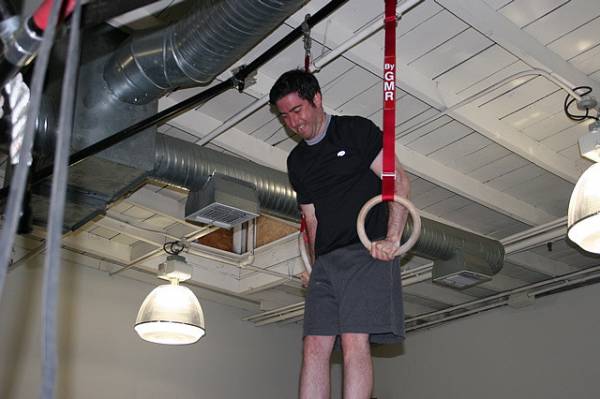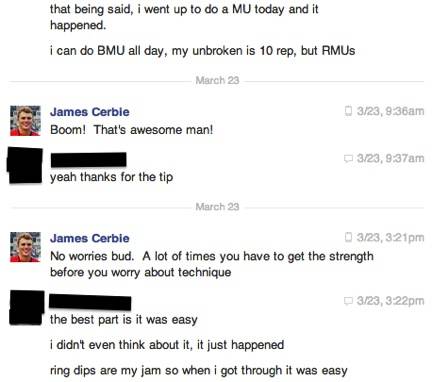Dammit…
Walk around, walk around, walk around…
Dammit…
Walk around, walk around, walk around…
Dammit…
You can see where this is going. A whole lot of dammit and a whole lot of walking around.
Enter the world of the aspiring muscle-up-getter. You try and try and try and try, but just can’t seem to get over the hump and nail your first ever ring muscle up. You’ve even spent hours doing technique work, playing with bands, and watching Carl Paolitalk about muscle up progressions.
So what gives?
Here’s what gives: I’m willing to bet you’re just not strong enough.
The Question
Whenever someone contacts me about not being able to do a muscle up, my first question (after doing an assessment of course) is always: How are your strict pull-ups?
And here’s why: In my opinion, the strict pull up has the greatest transfer of training to the muscle up. (If you’re interested in reading more about transfer of training then checkout Dr. Anatoly Bondarchuck’s books Transfer of Training In Sports Volume 1 and Volume 2)
I have yet to meet a single individual who has good pulling strength that cannot do a ring muscle up. Rather, I routinely meet people who spend way too much time worrying about technique when the real issue is they just lack the strength necessary to perform the movement.
Don’t get me wrong, technique is always important, and I’m not telling you to go look like a baboon humping a tree when you do a muscle up. I’m just saying that you’re wasting time on technique work when you haven’t hit the strength threshold to perform it. That’s like trying to practice having good technique with a 300lb snatch when you can only snatch 135. It just doesn’t work.
In other words, every skill can be looked at in terms of motor potential and technical mastery:
Motor potential: “The power output of competition exercise is always determined by the muscular capacity to produce the greatest quantity of mechanical energy per unit of time. This capacity is called the functional power of the motor system or motor potential.”1
Technical mastery: “The athletes skill to effectively express his motor potential in competition is called technical mastery.”1
From the above definitions it’s easy to see that motor potential must come before technical mastery because all technical mastery does is enhance your ability to express your motor potential. To summarize: If the motor potential is there then spend more time on technique work. If the motor potential isn’t there, then spend time getting it.

The Key to Conquering the Elusive Muscle Up
Hopefully I’ve convinced you of the need to get stronger, and here’s how you’re going to do it…
The Pull
This is where the vast majority of people get stuck. They simply aren’t strong enough to pull themselves over the rings and get to the dip. Thus, we need to increase your pulling strength and power and help you fly up the rings like a monkey.
Step 1. Start implementing any of the following pulling variations two times a week, with preference being given to the strict neutral grip pull up and strict ring pull up because they are the most specific options:
- Strict pull up
- Strict chin up
- Strict neutral grip pull up
- Strict ring pull up
Step 2. Watch this video for a primer on good technique:
Step 3. Adhere to the following set and rep scheme:
For the next four weeks I want you to not attempt a single muscle up, but perform the following twice a week preferably separated by two days of rest. Also, the reps are low so that you can load these up. Thus, go as heavy as you can on each set while maintaining good form.
- Week 1: 6×3
- Week 2: 8×3
- Week 3: 10x
- Week 4: 4×3
Furthermore, you’ll do a different pulling variation (see point one for options) on each of the two days.
Here’s an example of what four weeks might look like:

The Dip
In my experiences thus far, most people can do a ring dip. They may not be able to do a lot of them, but they can do at least one.In other words, this usually isn’t the sticking point for most people. With that being said, you still need to be confident and strong when it comes to the dip.Step 1. Ask yourself the following question: Can I do a strict ring dip?
Step 2. If you answered yes, then you’ll be doing the following set and rep scheme with ring dips. If you answered no, then you’ll be doing them on stationary pipes of some kind and progressing to the ring dips at another time. If you are a special case and can crush strict dips on stationary pipes, but flail around like a helpless child once you touch the rings, then you’ll be doing ring dips as well.
Step 3. Adhere to the following set and rep scheme for four weeks, and do so twice a week. Feel free to play around with using one day to do dips on stationary pipes and another day to go on the rings. Stick with whatever you choose to do for all four weeks though. Don’t go switching it up every week. Also, please add weight as necessary because these are meant to be loaded sets.
- Week 1: 4×6
- Week 2: 5×6
- Week 3: 5×6
- Week 4: 3×10 (attempt to use same weight from 5×6)
Here’s an example of what four weeks might look like:

Retest
You’ve busted your butt for four weeks and now it’s time to shine. Go ahead and retest your muscle up. You should notice a significant increase in your pulling power, if you didn’t add in more pulling variations on the side. And you should feel very strong on the dip portion of the movement.
If the muscle up still didn’t happen, then reevaluate where you are at, repeat the preceding cycle using two different pulling variations, and retest again after four weeks. Also, don’t forget the important role your core plays in this movement. If you cannot do a solid hollow rock hold then start practicing those as well.
Don’t bother testing your muscle up until you can get through all the sets with at least your body weight. Ideally, you’ll be able to do all the sets with at least ten to twenty pounds hanging on you.
Closing Thoughts
Although you may be skeptical, I promise the above method works. Just four weeks ago I had an individual contact me about his muscle up woes, and I prescribed him the above program. After following it, he hopped on the rings and crushed a muscle up without even blinking. Here’s a screen shot of the Facebook message he sent me:

At the end of the day, the ring muscle up is an awesome goal to shoot for and an adrenaline rush when you first do it. I hope this article helps you get over the hump, so you can cross it off your to do list.
If you have any questions feel free to post them below, and I’d love for you to tweet at me (@JamesCerbie) when you nail your first muscle up.
References:
1. Verkhoshansky, Y., and Verkhoshansky, N., “Determining Factors in Increasing the Power Output of Competition Exercise.”Special Strength Training Manual For Coaches. S.l.: Verkhoshansky Sstm, 2011. 31.
Photos courtesy ofCrossFit LA.






